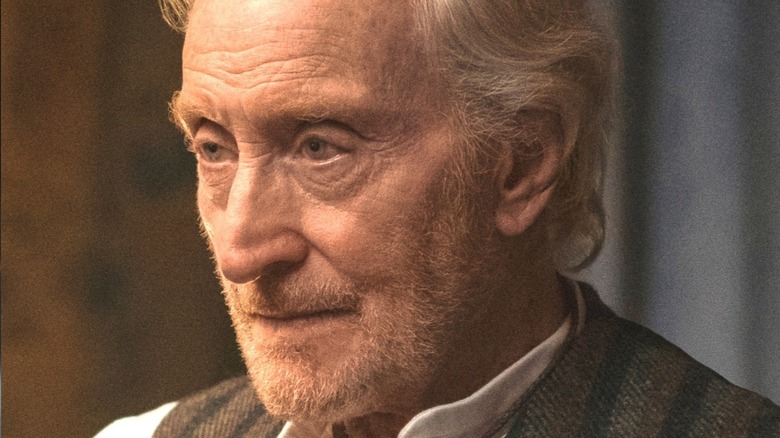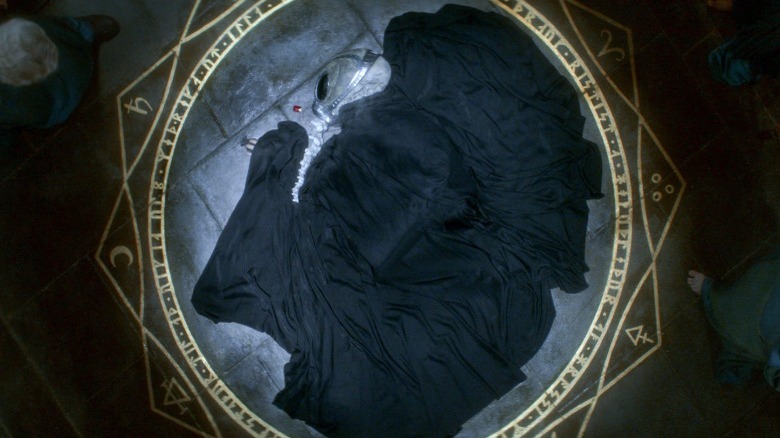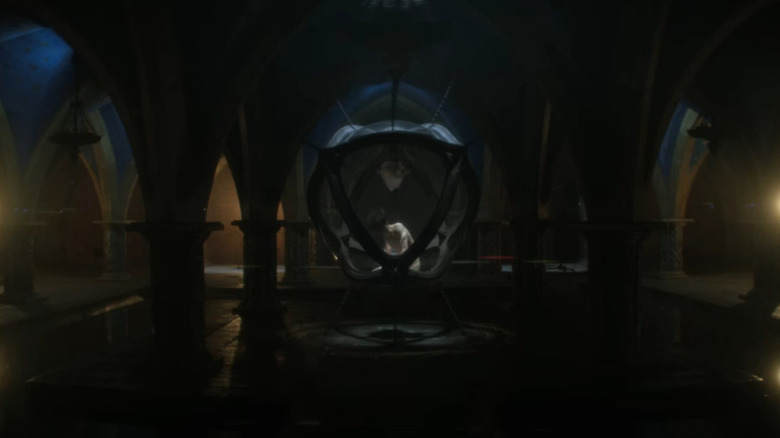The Real Reason Roderick Burgess Was Able To Capture Morpheus In Sandman
Contains spoilers for "Sandman"
Conjuring and capturing an anthropomorphic embodiment of an aspect of existence isn't exactly supposed to be an easy process. The Endless from Neil Gaiman's seminal "Sandman" are beings that represent facets of reality. They embody Dream, Destruction, Destiny, Delirium (who used to be Delight), Desire, Despair, and Death. As noted by Dream — aka Morpheus in his current iteration (Tom Sturridge) — The Endless have existed long before this universe came into being, and will exist long after the last embers burn out.
Few mortals even know of their existence, let alone can harness an ability to ensnare and imprison said god-like beings. However, this is exactly what happens to Dream at the outset of "Sandman" — he is captured by a cult of petty magic users known as The Order of Ancient Mysteries, led by Roderick Burgess (Charles Dance). Unfortunately, this collection of wannabe magi are hardly adept; their original intention is to capture Death (Kirby Howell-Baptiste) in order to demand the resurrection of past love ones. Instead, they pull her younger brother Dream from his duties, and bind him in a glass prison surrounded by magical runes that prevent him from using his powers.
Considering Dream's overwhelming cosmic power, how did a group of amateur magic users manage to pull off such a feat? Gaiman actually took it upon himself to provide that answer in dazzling form decades after the debut of "Sandman."
The Sandman: Overture tells the tale
Although Dream comments on his unlikely imprisonment in the Netflix adaptation, he doesn't mention how Roderick Burgess was able to accomplish such a feat with but a simple incantation and assortment of magical reagents. That being said, probably the easiest explanation as to how a bunch of blue bloods were able to forcibly imprison Dream is best illustrated by his comic book origins and backstory.
The very first issue of Neil Gaiman's "Sandman," which was released in 1989, picks up exactly where the Netflix series starts, and Morpheus mentions that a recent event has left him greatly weakened, but this is never elaborated on. However, in 2013 Gaiman released a prequel series called "Sandman: Overture" which finally expounds on this mysterious event that left Dream so egregiously weakened Sandman Fandom.
In "Overture," Dream is forced to go on a reality-spanning quest to understand a plague of insanity that is sweeping through the universe. He meets different aspects of himself from different planets, and even comes across his father, the embodiment of time, and his mother, the embodiment of night. Eventually, the source of madness is revealed to be his past handling of a Vortex — someone like Rose from the main narrative. Needless to say, Vortexes present a unique challenge for Dream and usually need to be resolved — permanently.
Morpheus eventually learns what must be done to save existence, and the results leave him weakened
"Overture" is a real trip. Written once again by Gaiman with accompanying art by comics rock star J.H. Williams III, the story lives up to its source material, which is really saying something.
Morpheus' adventure in the prequel not only sees him run into his proverbial parents, but his siblings Delirium, Destiny, and Desire as well, but Desire's role in the story is generally obfuscated. Morpheus is forced to destroy an entire planet, but relents when it comes to the destruction of an entire galaxy, because he feels as if there has been enough destruction for the day. It's only from the center of a black hole that he realizes what he must do to save the universe. Combining his own abilities with that of an alien child named Hope (who is the source of the Vortex), they channel the power of dreams to help change reality, and Morpheus guides the dreamers to this new existence. It's this effort — on par with the creation of a new universe — that leaves Morpheus greatly weakened and susceptible to the petty spells of the Order of Ancient Mysteries.
Speaking with Vulture, Neil Gaiman said of this prequel story, "Having just finished the whole of 'Overture,' it gave me a whole chunk of insight into the first story line [of Sandman], which I didn't have when I wrote it. There was stuff that I sort of knew. I knew that Dream was exhausted beyond all trying when the story began. I knew he had come from a victory of a sort, and I knew it was galaxies away. I knew how absolutely tired and trashed he was."
So, to answer the initial question, the reason why Roderick Burgess is able to capture Dream is on account of Dream having just saved multiple universes, past, present, and future.


